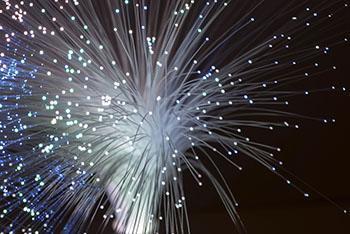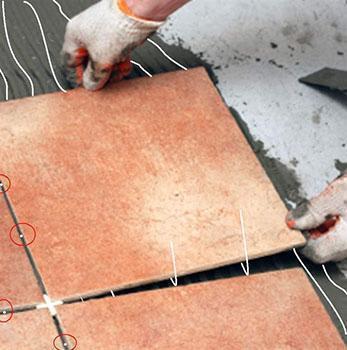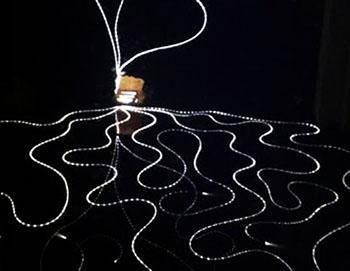Bright floors with optical fiber
Post from EditorialsWith optical fiber you can create floors that shine in the dark, with effects similar to a starry sky or a carpet with arabesques.
What are optical fibers?
 The optical fibers - in the 50s initially developed for medical applications - consist of thin filaments in glassy materials or polymers that enables the conducting of light effectively within them: their main applications are in telecommunications (and in particular for fast transmission of internet data), in architecture, for example, to bring the sun light even in the remotest corners of a building using special sensors to sunlight, and also in fitting of interior spaces, which exploit the peculiar material's aesthetic characteristics, which looks like thin filaments very flexible, translucent and white.
The optical fibers - in the 50s initially developed for medical applications - consist of thin filaments in glassy materials or polymers that enables the conducting of light effectively within them: their main applications are in telecommunications (and in particular for fast transmission of internet data), in architecture, for example, to bring the sun light even in the remotest corners of a building using special sensors to sunlight, and also in fitting of interior spaces, which exploit the peculiar material's aesthetic characteristics, which looks like thin filaments very flexible, translucent and white.
Tile floors and optical fibers
In the architecture of interiors, one of the most interesting applications of the optic fibers is creating floors with extraordinary visual effects: in fact, thanks to their technical characteristics, you can get flooring that - once off or dim the lights - will bright with their own light with effects similar to those of a starry sky or dark carpets with elegant shining arabesques.
Having a detailed final design, their implementation is not particularly complex, because some companies in the sector, including for example the GF Elettronica, have devised special kits consisting of fiber bundles and LED lights projectors for creating visual effects supplied complete with all accessories and installed in floors of any material.
Furthermore, the light can be of various colors, including red, green, blue, warm white, cool white and even multicolor: installing optical fibers between the joints of a normal tile floor - and then with a provision according to a geometric and modular pattern - the final effect is like a starry sky, while when appropriately selecting the most suitable types of tiles, you can also make outdoor flooring, especially suitable for balconies, verandas, terraces and flat roofs. The processing cycle of these floors involves the following steps:
The processing cycle of these floors involves the following steps:
- Preparation of a normal screed;
- Application of the adhesive;
- Laying of the optical fiber directly above the glue;
- Provision of the spacers for the creation of the joints between the tiles;
- Laying the tiles;
- Bending of some optical fiber bundles upwards, in correspondence of the joints;
- Grouting;
- Cutting of the bundles of optical fibers flush with the floor;
- Final cleaning.
Of course, you must observe some additional precautions, such as having the presence of mind not to twist and/ or bend over optical fibers to avoid damaging them, carefully connect the lights to led to the fiber bundles, and then insert the plugs protect fiber in the adhesive in order to prolong their duration in time.
Resin floors and optical fibers
 Without any doubt optical fibers give the best in resin floors, because the versatility of this material allows a very large range of expression.
Without any doubt optical fibers give the best in resin floors, because the versatility of this material allows a very large range of expression.
Indeed, in this case we get a real double face floor, because in the full light the most conspicuous element becomes the resin surface, polished and perfectly smooth, plain or decorated with geometric designs or even fantasy (being the virtually endless possibilities offered by the material); while in the dark and in the shadow emerge the fiber bundles, which may be protected or even enhanced by elegant pieces of glass or diskettes, and especially the play of light of the LEDs, which can even change color in a predetermined sequence.
Therefore, in the catalogs of the companies in the sector or between projects of interior designers - including for example the Company Clay Style of Milan - next to realizations again similar to a starry sky (and regular arrangement of points as in tile floors or random), we find beautiful examples of intricate arabesques and spirals, often with delicate sinuous and curvy swirls to accommodate the natural flexibility of the optical fibers.
Furthermore, for added decorative richness, optical fibers can be juxtaposed with inserts of various materials, including such pieces of stone, stained glass (opaque, translucent or transparent) and even mother-of-pearl, or strips of metal - especially steel, brass and aluminum - in different shapes.
It is of course also possible to create your own customized solution with a design specifically designed by an architect: These design solutions lend themselves so well to both environments rather large, as the living-dining area and a living room, both spaces of passage as lobbies, corridors and open internal stairs.
79735 REGISTERED USERS










